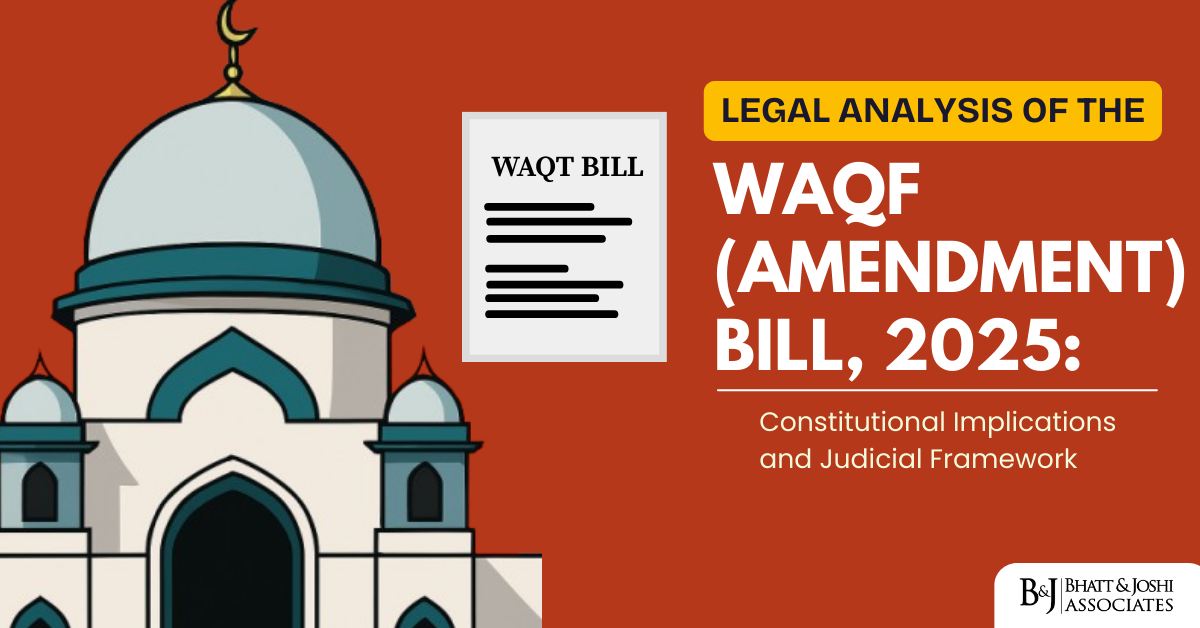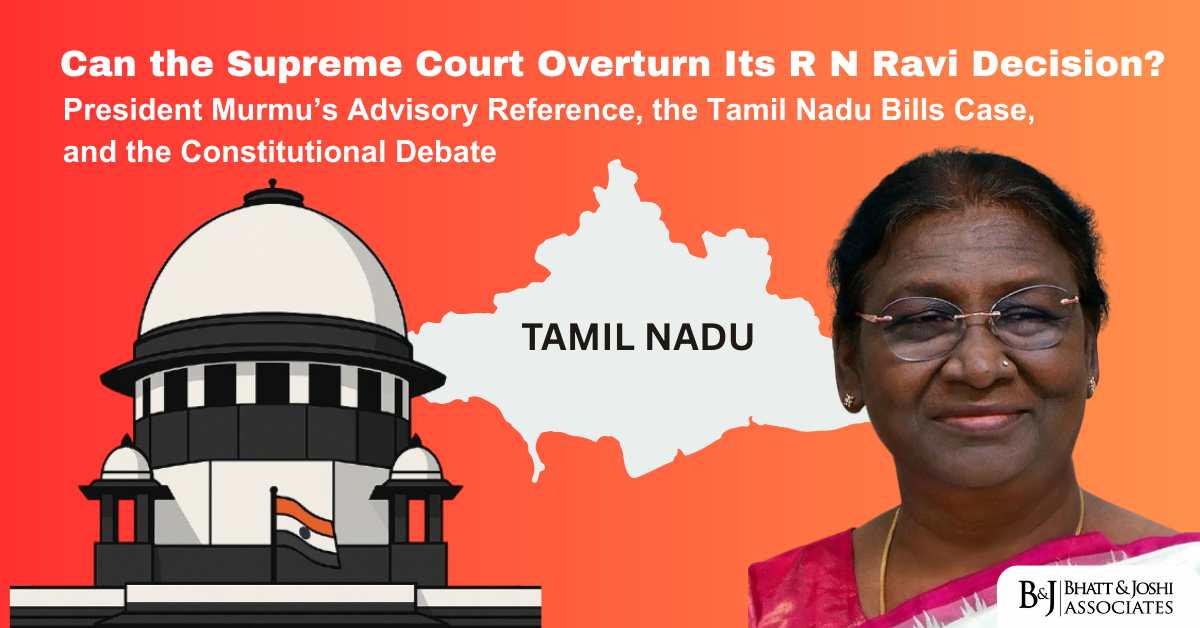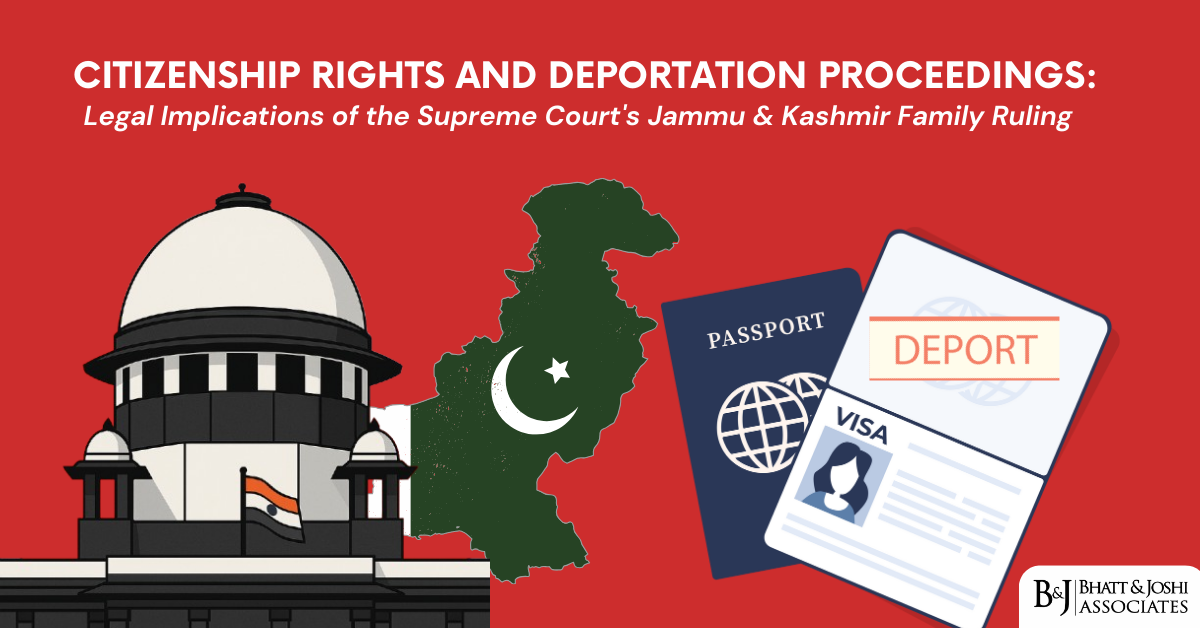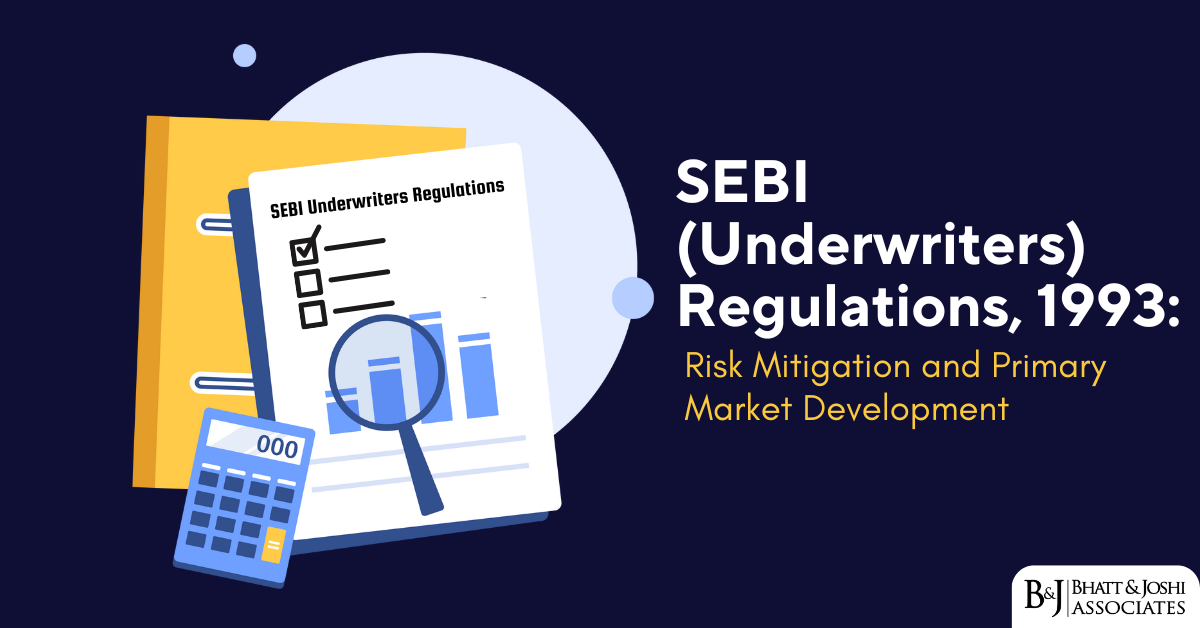By Adv. Aaditya Bhatt

Introduction
The recent passage of the Waqf (Amendment) Bill, 2025 by both houses of Parliament marks a significant development in the legal framework governing Waqf properties in India. After a marathon debate spanning over 12 hours in the Lok Sabha and approximately 17 hours in the Rajya Sabha, the Bill received final approval on April 4, 2025, with 128 votes in favor and 95 against in the Upper House. This comprehensive amendment to the Waqf Act, 1995 introduces substantial changes to the administration, governance, and oversight of Waqf properties, raising important questions about constitutional principles, minority rights, and established legal precedents.
This article endeavors to provide a thorough legal analysis of the Waqf (Amendment) Bill, 2025, examining its provisions through the lens of constitutional jurisprudence, relevant case law, and the evolution of Waqf legislation in India. As legal practitioners, it is imperative to understand not only the letter of the law but also its potential implications for religious institutions, property rights, and the delicate balance between state regulation and religious autonomy.
Historical Context and Evolution of Waqf Laws in India
To properly contextualize the current amendments, we must first understand the historical evolution of Waqf laws in India.
Pre-Independence Legal Framework
The concept of Waqf has deep historical roots in Islamic jurisprudence, dating back to the early days of Islam. In the Indian subcontinent, Waqf properties have been governed by a combination of Islamic law (Sharia) and colonial legislation. The first significant legislative intervention came with the Mussalman Wakf Act of 1923, which was enacted during British rule to regulate Waqf administration.
The 1923 Act, which has now been repealed alongside the 2025 amendments, primarily focused on establishing a framework for registration and management of Waqf properties. It required mutawallis (managers of Waqf properties) to provide statements of accounts and property details to the government. However, it had limited scope and enforcement mechanisms.
Post-Independence Developments
After independence, recognizing the need for more comprehensive legislation, the government enacted the Wakf Act, 1954. This Act established state Wakf Boards and provided for a more structured governance mechanism. The 1954 Act was later replaced by the more comprehensive Waqf Act, 1995, which consolidated previous legislation and introduced additional provisions for better administration and protection of Waqf properties.
Significant amendments were made to the 1995 Act in 2013, primarily to address issues of encroachment of Waqf properties, strengthen the powers of Waqf Boards, and improve the management of Waqf assets. The 2013 amendments also introduced provisions to ensure representation of women and persons with expertise in finance or administration on Waqf Boards.
Key Provisions of the Waqf (Amendment) Bill, 2025
The Waqf (Amendment) Bill, 2025, introduced as UMEED (Unified Waqf Management Empowerment, Efficiency and Development), brings several substantial changes to the existing framework. A critical legal analysis of these provisions reveals both potential benefits and areas of constitutional concern:
1. Composition of Waqf Boards and Central Waqf Council
One of the most contentious aspects of the Bill is the modification of the composition of Waqf Boards and the Central Waqf Council to include non-Muslim members. Specifically:
- The Central Waqf Council will consist of 22 members, including ex-officio members, with up to four non-Muslim members.
- State Waqf Boards will have 11 members, with up to three non-Muslim members.
From a constitutional law perspective, this provision raises questions about Article 26 of the Constitution, which guarantees religious denominations the right to manage their own affairs in matters of religion. In Ratilal Panachand Gandhi v. State of Bombay (1954), the Supreme Court held that the right to manage religious affairs is a fundamental right protected under the Constitution.
However, it’s equally important to note that in AS Narayana Deekshitulu v. State of Andhra Pradesh (1996), the Supreme Court recognized that the state can regulate secular activities associated with religious institutions. Since Waqf Boards are statutory bodies tasked with managing properties with significant economic and social implications, the inclusion of non-Muslim members could potentially be justified as ensuring better secular administration.
2. Property Dispute Resolution Mechanism
The Bill strengthens Waqf tribunals through a structured selection process and fixed tenure to ensure efficient dispute resolution. It also introduces a provision requiring an officer above the rank of collector to investigate government properties claimed as Waqf.
This provision addresses a significant area of contention that has been the subject of numerous legal disputes. In Board of Wakfs, Maharashtra v. Haji Saboo Siddik Falahi (2011), the Supreme Court emphasized the importance of proper adjudicatory mechanisms for Waqf property disputes. The enhanced tribunal framework can potentially facilitate more efficient resolution of disputes, aligning with judicial precedents that have called for specialized adjudication in Waqf matters.
However, the elevation of the investigative authority to an officer above the rank of collector represents a significant departure from the existing framework. This change must be evaluated in light of the Supreme Court’s observations in Karnataka Board of Wakfs v. Government of India (2004), where the Court highlighted the need for balance between administrative discretion and protection of Waqf interests.
3. Audit and Financial Oversight
The Bill mandates that Waqf institutions earning over ₹1 lakh will undergo audits by state-sponsored auditors, while reducing mandatory contributions from Waqf institutions to Waqf boards from 7% to 5%.
Enhanced financial oversight aligns with the principles outlined in Committee of Management Kanya Junior High School Bal Vidya Mandir v. Sachiv, U.P. Basic Shiksha Parishad (2006), where the Supreme Court recognized the legitimate state interest in ensuring proper management of institutional finances. However, the specific implementation of audits by state-sponsored auditors must be evaluated against the principle of institutional autonomy established in TMA Pai Foundation v. State of Karnataka (2002).
4. Centralized Management System
The Bill introduces a centralized portal to automate Waqf property management, aimed at improving efficiency and transparency.
This technological modernization can be viewed through the lens of the Supreme Court’s observations in Faizan Hasan Mavia v. Union of India (2019), where the Court acknowledged the need for modernization in religious institution management, while cautioning against excessive interference in religious matters.
5. Women’s Rights Provisions
A noteworthy aspect of the Bill is its focus on protecting women’s inheritance rights. It stipulates that women must receive their inheritance before Waqf declaration, with special provisions for widows, divorced women, and orphans.
This provision addresses concerns raised in cases like Shayara Bano v. Union of India (2017), where the Supreme Court emphasized the need to protect women’s rights within the framework of personal laws. The explicit protection of women’s inheritance rights before Waqf declaration represents a progressive step that aligns with constitutional principles of gender equality under Articles 14 and 15.
Constitutional Analysis of the Waqf (Amendment) Bill 2025
The Waqf (Amendment) Bill, 2025 must be analyzed through the prism of several constitutional provisions and principles:
Article 14: Right to Equality
The principle of non-discrimination is central to our constitutional framework. The inclusion of non-Muslim members in Waqf boards raises questions about differential treatment based on religion. However, in Indra Sawhney v. Union of India (1992), the Supreme Court recognized that Article 14 permits reasonable classification for achieving specific objectives. If the inclusion of non-Muslim members can be demonstrably justified as enhancing administrative efficiency and transparency, it might withstand constitutional scrutiny.
Article 25 and 26: Freedom of Religion
These articles guarantee freedom of conscience and the right to freely profess, practice, and propagate religion, along with the right of religious denominations to manage their religious affairs. In Dr. M. Ismail Faruqui v. Union of India (1994), the Supreme Court distinguished between religious practices and secular activities associated with religious institutions, holding that the latter can be regulated by the state.
The central question is whether Waqf administration constitutes an essential religious practice protected under Article 25, or whether it falls within the realm of secular activities that can be regulated. Drawing from the precedent in Commissioner, Hindu Religious Endowments, Madras v. Sri Lakshmindra Thirtha Swamiar of Sri Shirur Mutt (1954), commonly known as the “Shirur Mutt case,” the distinction between religious and secular activities is crucial. The Court held that what constitutes an essential part of religion is to be determined with reference to the doctrines of that religion itself.
Article 29 and 30: Protection of Minority Interests
These articles protect the interests of minorities, including their right to establish and administer educational institutions. While not directly applicable to Waqf properties, these provisions reflect a constitutional commitment to protecting minority interests. In Ahmedabad St. Xavier’s College Society v. State of Gujarat (1974), the Supreme Court emphasized the importance of minority autonomy in managing their institutions.
The amendments must be evaluated in light of these constitutional protections for minorities. If the changes substantially dilute Muslim community control over Waqf properties without sufficient justification, they might face constitutional challenges.
Judicial Precedents on Waqf Administration
Several landmark judgments have shaped the legal understanding of Waqf administration:
Board of Wakfs, West Bengal v. Anis Fatma Begum (2010)
In this case, the Supreme Court clarified the scope of Waqf Boards’ powers, emphasizing that while the Boards have supervisory authority, they cannot arbitrarily interfere with mutawallis’ day-to-day management. The Court held: “The power of the Board is supervisory and not that of substituting itself in place of the mutawalli.”
This precedent raises questions about provisions in the 2025 amendments that potentially enhance state control over Waqf administration. The boundary between legitimate supervision and undue interference remains a delicate one.
Karnataka Board of Wakfs v. Government of India (2004)
This judgment addressed the contentious issue of identifying Waqf properties. The Supreme Court established criteria for determining whether a property qualifies as Waqf, emphasizing the importance of documentary evidence and historical usage.
The 2025 amendments’ provision requiring higher-ranking officers to investigate government properties claimed as Waqf must be evaluated against this precedent. The procedural safeguards in such investigations will be crucial for legal validity.
Ramesh Gobindram v. Sugra Humayun Mirza Wakf (2010)
In this case, the Supreme Court addressed the jurisdiction of Waqf Tribunals, holding that the tribunals have exclusive jurisdiction over disputes concerning Waqf properties. The Court’s interpretation of the Waqf Act emphasized the specialized nature of Waqf property disputes.
The amendments to strengthen Waqf tribunals align with this precedent, potentially enhancing the specialized adjudication mechanism for Waqf property disputes.
Comparative Legal Perspective
A comparative analysis with Waqf laws in other jurisdictions provides valuable insights:
Malaysia
Malaysia’s Wakaf (State of Selangor) Enactment 2015 provides for comprehensive regulation of Waqf properties while respecting religious autonomy. The Malaysian model includes non-Muslim representation in advisory roles rather than as voting members, potentially offering a balanced approach.
Egypt
Egypt’s Waqf Law of 1946 (as amended) maintains religious character while implementing modern governance mechanisms. The Egyptian system distinguishes between religious and administrative aspects, with state oversight focused primarily on the latter.
Turkey
Turkey has implemented a secular system of Waqf administration through the Foundations Law of 2008, which treats all religious endowments under uniform principles. This approach, while ensuring equality, has faced criticism for diluting the religious character of Waqfs.
The Indian amendments appear to adopt elements from both Malaysia and Turkey, creating a hybrid model that attempts to balance religious autonomy with secular governance.
Waqf (Amendment) Bill, 2025: Legal Challenges Ahead
Based on the analysis above, several aspects of the Waqf (Amendment) Bill, 2025 may face legal challenges:
1. Inclusion of Non-Muslim Members
This provision is likely to be challenged under Articles 25, 26, and 14 of the Constitution. The central question will be whether such inclusion substantially interferes with the religious character of Waqf administration or whether it is a reasonable measure to enhance administrative efficiency.
Applying the “essential religious practices” test from the Shirur Mutt case, courts will need to determine whether exclusive Muslim control over Waqf administration constitutes an essential religious practice in Islam.
2. Investigative Authority for Government Properties
The provision requiring officers above the rank of collector to investigate government properties claimed as Waqf might be challenged as creating an unduly high threshold, potentially violating the principle of equality under Article 14.
Courts will likely apply the test of reasonable classification and examine whether this provision creates a disproportionate burden on establishing Waqf claims compared to other property claims.
3. State-Sponsored Audits
The requirement for state-sponsored audits might be challenged as excessive governmental interference in religious institution management. The precedent in TMA Pai Foundation emphasizes institutional autonomy in financial management, which must be balanced against legitimate state interests in ensuring proper utilization of resources.
The Way Forward: Legal and Policy Recommendations
1. Implementation Guidelines
Detailed implementation guidelines should be developed to ensure that the amended provisions are applied in a manner consistent with constitutional principles. These guidelines should clarify:
- The specific qualifications and selection process for non-Muslim members of Waqf Boards
- The procedural safeguards in property investigations
- The scope and limitations of audit authority
2. Judicial Interpretation
Courts will play a crucial role in interpreting the amended provisions in light of constitutional principles. In particular, the courts should:
- Clarify the boundary between religious and secular aspects of Waqf administration
- Develop standards for evaluating whether specific provisions unduly burden minority rights
- Balance institutional autonomy with legitimate state interests in proper administration
3. Alternative Dispute Resolution
Given the contentious nature of Waqf property disputes, alternative dispute resolution mechanisms should be strengthened alongside formal tribunals. Mediation and arbitration can provide culturally sensitive forums for resolving disputes while reducing the burden on formal adjudicatory bodies.
4. Rights-Based Approach
Implementation should adopt a rights-based approach that explicitly recognizes and protects:
- Women’s inheritance rights in Waqf properties
- The interests of beneficiaries, particularly disadvantaged sections
- The legitimate autonomy of religious institutions
The Secular Character of Waqf Administration
A central argument advanced by the government in support of the amendments is that Waqf Boards, as statutory bodies, should be secular in character. This argument merits careful legal analysis.
In SR Bommai v. Union of India (1994), the Supreme Court elaborated on the concept of secularism as a basic feature of the Constitution, emphasizing that the state must maintain neutrality toward all religions. However, in Aruna Roy v. Union of India (2002), the Court clarified that secularism does not require the elimination of religion from public life but rather equal treatment of all religions.
The question, therefore, is whether the inclusion of non-Muslim members in Waqf Boards represents neutral state regulation or an infringement on religious autonomy. The answer depends on whether Waqf administration is characterized primarily as a religious or secular function.
Drawing from comparative jurisprudence, the Canadian Supreme Court’s approach in Syndicat Northcrest v. Amselem (2004) offers useful insights. The Court developed a subjective-objective test for determining religious practices, respecting sincere religious beliefs while considering objective factors. Applying this framework, the question would be whether Muslim community members sincerely view exclusive Muslim administration of Waqf properties as a religious obligation, and whether this view has objective support in Islamic jurisprudence.
Economic and Social Implications of the Waqf (Amendment) Bill, 2025
Beyond constitutional questions, the amendments have significant economic and social implications that intersect with legal considerations:
1. Economic Efficiency
The reduction of mandatory contributions from 7% to 5% and the introduction of a centralized portal for property management aim to enhance economic efficiency. In Mst. Bibi Sayeeda v. State of Bihar (1996), the Supreme Court recognized the legitimate state interest in ensuring efficient utilization of Waqf properties for public benefit.
2. Protection of Women’s Rights
The provisions protecting women’s inheritance rights represent a progressive step toward gender justice. In Danial Latifi v. Union of India (2001), the Supreme Court emphasized the importance of protecting women’s economic rights within personal law frameworks.
3. Impact on Beneficiaries
The ultimate test of the amendments will be their impact on the intended beneficiaries of Waqf properties. In Faqruddin v. Tajuddin (2008), the Supreme Court emphasized that the welfare of beneficiaries is paramount in Waqf administration.
Recent Legal Developments Influencing Waqf Jurisprudence
Several recent judicial pronouncements have shaped the legal landscape within which the 2025 amendments must be understood:
Maharashtra State Board of Wakfs v. Shaikh Yusuf Bhai (2022)
In this case, the Supreme Court clarified the evidentiary standards for establishing Waqf status, holding that documentary evidence must be supplemented by evidence of continuous religious usage. This precedent will be crucial in applying the amended provisions regarding property investigations.
All India Muslim Personal Law Board v. Union of India (2023)
This case, although focused on personal law rather than Waqf administration, established important principles regarding state intervention in religious matters. The Court emphasized the need for meaningful consultation with religious communities before legislative interventions affecting their practices.
Waqf Board of Delhi v. DDA (2024)
This recent judgment addressed the relationship between urban development authorities and Waqf Boards, establishing a framework for balancing development needs with protection of Waqf properties. The Court emphasized the need for collaborative approaches rather than adversarial contests.
Conclusion: Balancing Regulation and Religious Autonomy
The Waqf (Amendment) Bill, 2025 represents a significant attempt to modernize and reform Waqf administration in India. From a legal perspective, the amendments present a complex interplay of constitutional principles, religious rights, and administrative exigencies.
The constitutional validity of these amendments will likely hinge on whether they can be characterized as reasonable regulation of secular aspects of Waqf administration or whether they substantially interfere with the religious character of Waqf institutions. The doctrine of proportionality, increasingly employed by Indian courts in fundamental rights cases, will be crucial in evaluating whether the amendments strike an appropriate balance between legitimate state interests and religious autonomy.
As legal practitioners, our role extends beyond technical analysis to understanding the broader implications of these amendments for social harmony and constitutional values. The legislation’s stated objectives of enhancing transparency, protecting women’s rights, and improving administrative efficiency are laudable, but their implementation must respect the delicate constitutional balance between state regulation and religious freedom.
The ultimate test of these amendments will not be their theoretical coherence but their practical impact on the ground – whether they enhance or diminish the ability of Waqf institutions to fulfill their charitable and religious purposes while adapting to contemporary governance standards. This will require careful monitoring and, where necessary, strategic litigation to ensure that implementation aligns with constitutional principles.
In an era where religious institutions face increasing scrutiny and regulation, the Waqf amendments represent a significant case study in negotiating the complex relationship between secular governance and religious autonomy. The legal community must engage thoughtfully with these issues, advocating for interpretations and applications that honor both our constitutional commitments to secularism and the legitimate autonomy of religious institutions.
References
Statutory Materials
- The Waqf Act, 1995
- The Waqf (Amendment) Act, 2013
- The Mussalman Wakf Act, 1923
- The Waqf (Amendment) Bill, 2025
Case Law
- Ratilal Panachand Gandhi v. State of Bombay (1954) SCR 1055
- Commissioner, Hindu Religious Endowments, Madras v. Sri Lakshmindra Thirtha Swamiar of Sri Shirur Mutt (1954) SCR 1005
- Ahmedabad St. Xavier’s College Society v. State of Gujarat (1974) 1 SCC 717
- SR Bommai v. Union of India (1994) 3 SCC 1
- Dr. M. Ismail Faruqui v. Union of India (1994) 6 SCC 360
- AS Narayana Deekshitulu v. State of Andhra Pradesh (1996) 9 SCC 548
- Mst. Bibi Sayeeda v. State of Bihar (1996) 9 SCC 516
- TMA Pai Foundation v. State of Karnataka (2002) 8 SCC 481
- Karnataka Board of Wakfs v. Government of India (2004) 10 SCC 779
- Board of Wakfs, Maharashtra v. Haji Saboo Siddik Falahi (2011) 14 SCC 16
- Shayara Bano v. Union of India (2017) 9 SCC 1
- Maharashtra State Board of Wakfs v. Shaikh Yusuf Bhai (2022) 7 SCC 112
Disclaimer: The views expressed in this article are the personal opinions of the author and do not constitute legal advice. Readers are advised to consult qualified legal professionals for specific legal matters.













